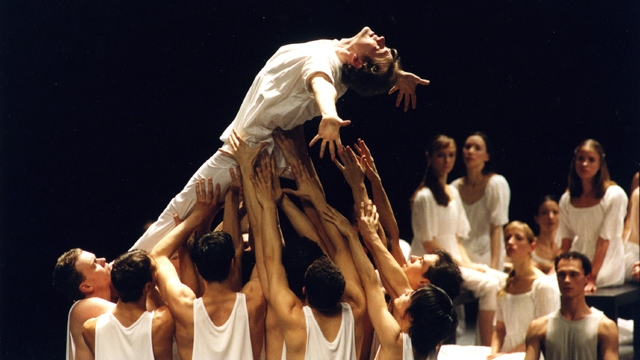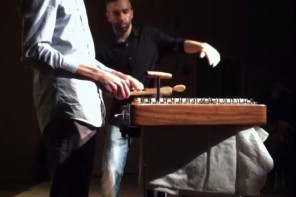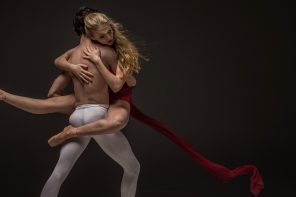Many times in conversation, having described the marvelous sophistication of thought that goes into dancing and choreography, if I do not receive a blank stare, I hear something along the lines of, “I have a hard time watching dance because I don’t understand it.” More than most art forms, dance historically has been painfully vulnerable to audience befuddlement. Not to mention wariness, if you consider a genre like ballet, which suffers the common stereotypes of pink tutus, swan feathers, and men in tights. The Church has often raised her eyebrows at dance, or ignored it, but she herself is in rehearsal for something grand; and though she may forget it, from the Middle Ages to even now, whether in churches or dark theaters, glimpses and echoes of the Choreographer’s designs already have been performed, and shall continue to be so.
Dance has the wonderful power to express symbol, idea, human nature, even narrative, but the average audience is not trained to estimate the technical quality of the dance. In this regard, dance is just like any other art form. One’s appreciation of a painting, for example, is enhanced by a greater knowledge of and attention to the visual elements that make up a painting (e.g., line, shape, color, composition, etc.) and the context in which the painting was produced.
When you attend a dance performance, what might be helpful to observe? Try to observe a dancer’s expression (though some dancers will be technicians and not emote very much); the quality of their movement (is it aggressive? languid? subtle? meticulous?); and perhaps whether the groups of dancers resemble any particular social community (friends? a wedding party? ghosts? angels? even the framework of a building?). If there was a plot, what did it suggest about the culture that produced it? How was your imagination engaged, by the dancers, the set, the costumes? Did the dancers move in sync with the music, or against it? In more abstract performances, some of the greatest choreography transforms dancers into music incarnate, so that you are not so much watching humans, but rather the notes the orchestra played. In these cases, you can enjoy the sheer beauty of the ornate steps much like you would enjoy ornate architecture, only with humans instead.

For any readers new to dance, I can recommend several excellent performances, many of them accessible (even if in bits) to anyone with a search engine and a few minutes. Imagine in your mind’s eye, for a minute, a scene from John Neumeier’s work Matthaus Passion. Christ, lying on his back, is lifted up by the kneeling Twelve, only to be brought down to the (implied) table of the Last Supper. They bow their heads over him, symbolizing Communion, the partaking of his body, before lifting him once more, this time into a seated position. (Christ, once fed upon, assumes the throne, willingly and literally made by human hands). Or take the various repeated moments in Christopher Wheeldon’s medievalist ballet Misericordes, where the single figure dressed in white, the leader of unity and order, quietly moves in the background of a darkened stage, so that the ballet’s overarching atmosphere invokes Flannery O’Connor’s powerful phrase, “Christ-haunted.” I also think of George Balanchine’s ballet Prodigal Son, which loosely retells the Gospel parable: a terrible, seductive character known as the Siren takes the innocence of the Prodigal, calling to mind Proverbs 5:3-6 and 30:20.
One final note: “Graceful” is a common description of dancing. Yet when we watch dance—no matter the genre or piece, story or abstract, spiritual or secular—and we see all its unceasing attack, its severity, its richness, its generosity of movement, I think we might come to see a Grace much more real—incarnate?—than that ordinary definition of “light,” or “airy.”
What do you think? Do you have any reservations about watching dance, and if so, what are they? What might be some advantages and challenges that choreography faces when striving to share the Word, when dance does not communicate with the human tongue?
Marilyn Leider is just about to graduate from UC Irvine with a Bachelor’s in English. She plans to spend the rest of her life educating people about dance, T. S. Eliot, and the Middle Ages.
_________________
Image credit: Philharmonie Essen. Choreography © John Neumeier. Photo © Holger Badekow. Image used under fair use for educational purposes.





Nice article.
Pls check out my work:
Karinstevensdance.com
Hi Karin,
Glad you liked my article! I hope you found it useful.
I checked out your website and watched some of your choreography! As I watched, I was thinking about motivation and what informed the geometry– both your ideas and your dancers’ hearts and minds. All the pieces looked abstract; was there a particular reason (emphasis on musicality, shape, etc.?). Would love to hear your thoughts. Thanks!
Thought provoking educational article written by an obviously talented dancer and writer. I agree that educating the audience or lack of audience is a function perhaps never quite fully embraced but quite powerful in terms of extending knowledge to a hesitant viewer. I look forward to reading more and deeper dives into particular ballets especially those which are contemporary with perhaps no story but just pure movement aligned with music. Thank you Miss Leider for the educational advance of dance!
Hi Natalie!
Thanks so much for your encouragement! Yes, so many of the abstract ballets are profound and deep to the soul– some deeper than narrative ballets. (The same goes for other kinds of dance). I hope to educate others about these works as well!
And not just ballet. There are Modern choreographers that make for excellent inroads to appreciating dance for something more than TV competition. Jose Limon, and in particular _There is a time_. There is also Pilobolus and their master piece _Gnomen_. Great introductions to dance. Some of my current favourite contemporary choreographers include Jiri Kylian and William Forsythe. If you get a chance to see a performance of Anthony Tudor’s _Dark Elegies_ you’ll see a community contending with loss and mourning.
For just shear beauty, it is hard to resist Balanchine’s _Concerto Barocco_ or Paul Taylor’s joyous _Aureole_. These are works based more on form and emotion than narrative.
Joe
Hi Jfutral!
I confess that my experience lies primarily with ballet, but I agree– modern and contemporary dance are capable of just as much beauty as ballet, and other kinds of dance as well. You name so many of the Greats! I would say Alvin Ailey, Dance Theatre of Harlem, and Lines are current non-ballet companies performing deeply spiritual and meaningful works– what do you think? And do you think Forsythe, for all his brilliant geometries and electric scissorwork, has produced anything meaningful?
I work for Hubbard Street Dance Chicago (production Manager) and we are currently performing Forsythe’s Quintett. It is one of the most beautiful works I’ve seen. Drives my tech staff a bit nuts with the same bit of music playing over and over. It is a very personal work for him and hs friend’s, so that could make the difference. But then I’m drawn to the bitter-sweet. (Picasso affects me similarly. I can usually sense when he was working from his heart more than from “commission”)
We are also collaborating with Alonzo King’s Lines on a new work, Azimuth. He is a deeply rooted man as is his work. I can understand the attraction.
Alvin Ailey is perennial. I am curious to see where Robert Battle will take them choreographically.
Joe
(Hubbard!! UC Irvine was so proud and honored to have the company last summer! And I’m Thankful for your knowledge and the conversation we are having).
I’m glad you had me go after a Quintett rabbit hole. Never heard of the piece, so thanks. The Youtube clips seem too short to do it justice, but I looked up the context and found a neat interview with Forsythe that didn’t necessarily have to do with Quintett, but it was an interesting glimpse of his very theoretical approach to dance.
http://www.movementresearch.org/criticalcorrespondence/blog/?p=5213
And the Gavin Bryars-musical choice makes it a sort of ritual, an endurance to hear it through to the end. Ritual as defined– a repetition that expands upon the first, makes its meaning from the “againness.”
Christopher Wheeldon has produced a contemporary pas-de-deux (actually, I prefer the whole 20 minute version) called After the Rain, which frequently brings the audience to tears. But in every interview about AtR, he says he felt absolutely nothing, just wanted to make beautiful shapes to music. I have a hard time believing him, but why would he lie?
You mentioned commissions– lately Wheeldon’s been commissioned for so many pieces and ballets, and I am starting to fear his quality is slipping.